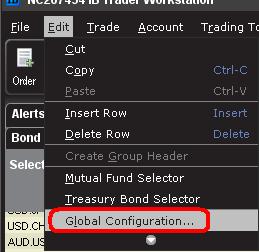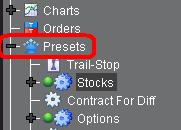TWS Message: Order price relative to the market.
The TWS contains two checks to limit the possibility of clients entering trades at prices which are substantially inconsistent with that of the current market.
Under the first check, stock buy orders which are 10% above the prevailing NBBO ask price will be automatically rejected by IBKR as will stock sell orders which are 10% below the prevailing NBBO bid price. In the case of options, IBKR's automatic rejection threshold percentage for both buy and sell orders is 20%. When an order violating these parameters is transmitted, it will be rejected and a TWS pop-up window will be displayed with the following warning message: "Limit price too far outside NBBO" or "This order is not accepted. The limit price cannot be more than 10% through the NBBO.".
The second check relates to orders which are transmitted at prices which do not violate the parameters set by IBKR as outlined above, but which do violate parameters established by the account holder. Here the account holder is able to establish Precautionary Settings by selecting the Order and then Configure Order Presets menu options from the TWS. This will open up a window providing for the creation of price thresholds set in terms of percentage or the number of ticks outside of the NBBO (settings may also be defined in terms of share/contract quantity or total dollar value of trade). When an order violating the account holder's parameters is transmitted, it will be rejected and a TWS pop-up window will be displayed with the following warning message: "The price specified would violate the percentage constraint specified in the default order settings. Do you really want to submit this order?" Unlike in the case of the check set by IBKR, the account holder has the option of overriding their own settings and transmitting the order by clicking on the "Yes" button.
How can I trade stocks during the pre-market or post-market?
By default, orders for some products are entered with a restriction referred to as Regular Trading Hours (RTH) Only. This restriction may prevent submitted orders from executing during the pre and post market sessions. The following article will clarify this time restriction as well as how it can be modified.
There are risks inherent in trading outside of Regular Trading Hours (RTH) including reduced liquidity, increased volatility, and expanded error trade guidelines that traders should be aware of and willing to assume prior to transmitting active orders into the market during these times.
Contents:
How to determine if a submitted order has a RTH restriction applied.
Changing Default Settings
Other Important Notes
How to determine if a submitted order has a RTH restriction applied.
Trader Workstation (TWS)
Orders restricted to RTH only will display a clock icon in the Time in Force (TIF) field.
Hold your mouse over the clock icon to display information regarding when the order can be filled.
Orders without a time restriction will either display no clock icon or will display the clock icon with an exclamation point over it to indicate that it will be active outside of the regular trading session.
Traders may change the RTH setting by clicking this field before the order has been transmitted. From the dropdown that appears, check the box that says "Fill outside RTH".
IBKR Mobile
To check to see if your order is eligible to fill outside of regular trading hours, go to the Orders & Trades tab (iOS) or the Orders tab (Android) and tap on the order in question. If using the iOS app, there will be a line item stating if the order is eligible to fill outside of regular trading hours:
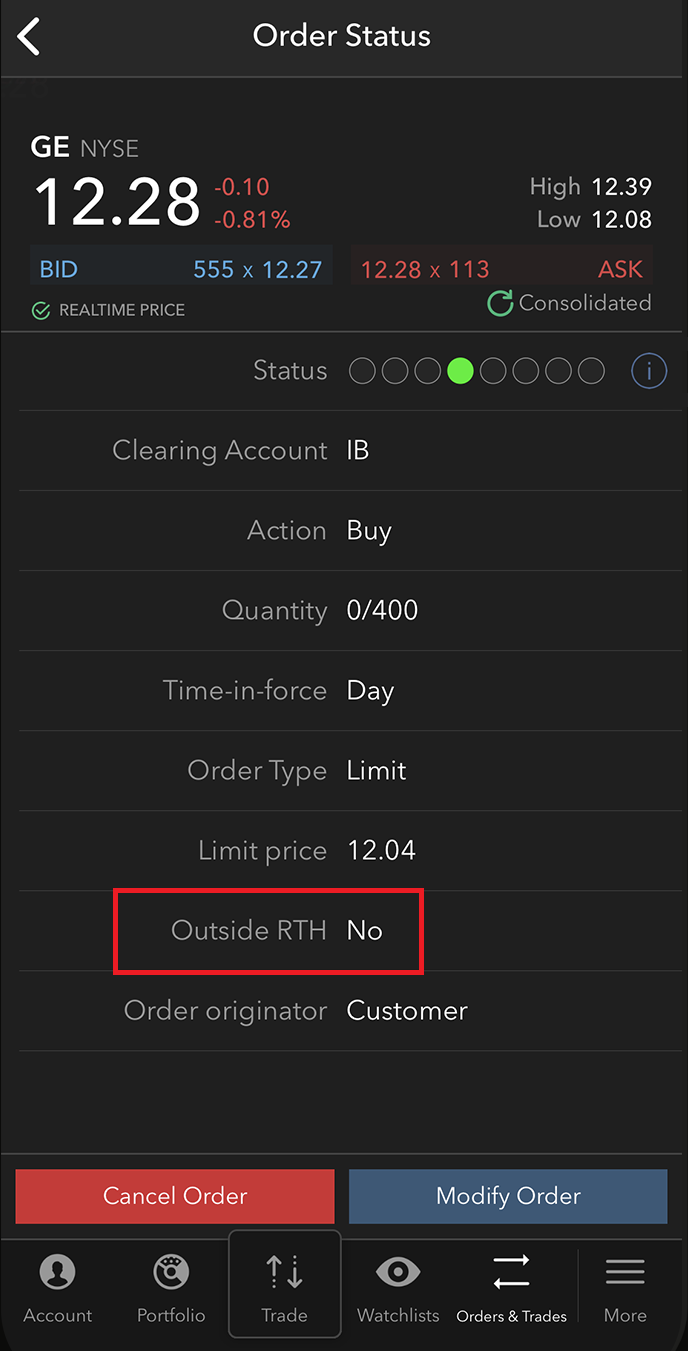
If using the Android app, there will be a line item for Time-in-force. Click the small arrow on the right side to expand the section. There will be a line item for Outside RTH with a toggle that will be set to ON (eligible to fill outside RTH) or OFF (not eligible to fill outside RTH).
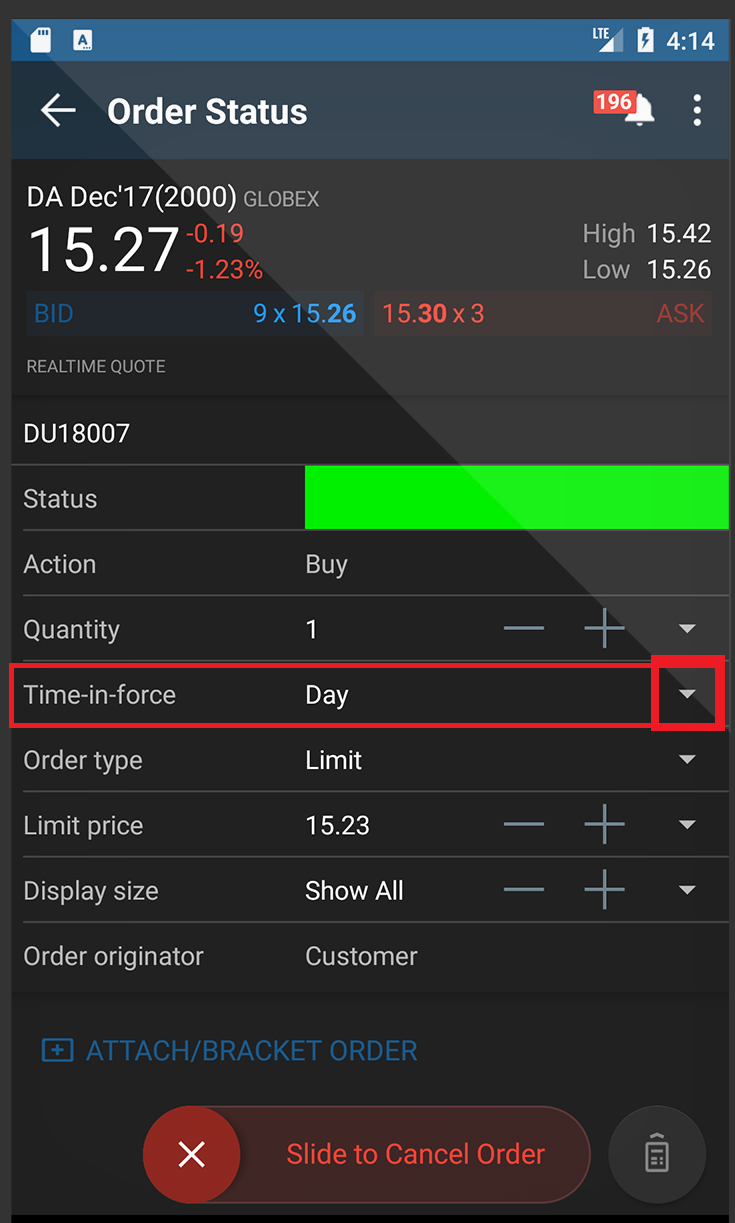
Clients can set their order to fill outside regular trading hours through the IBKR Mobile Order Ticket. In both the iOS and Android versions of IBKR Mobile, the Order Ticket will have a line item where you can toggle Outside RTH on or off. Once you have made your election, fill out the remainder of the Order Ticket and submit when ready.
iOS:
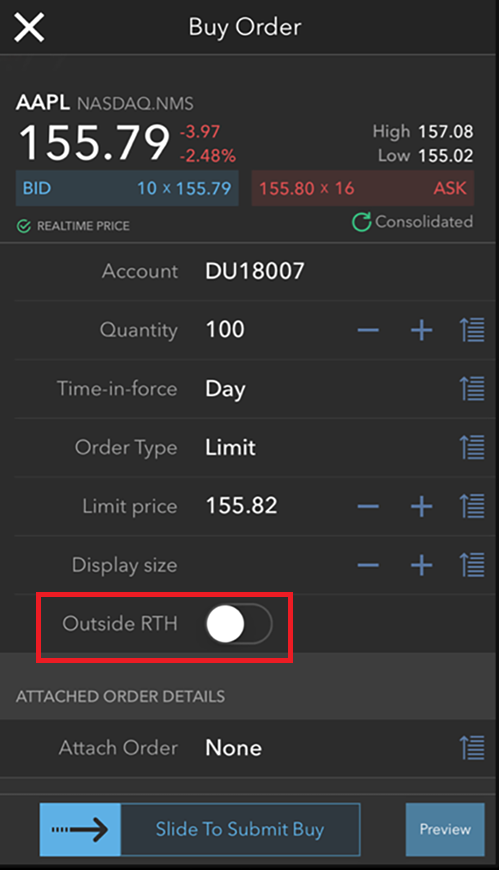
Android:
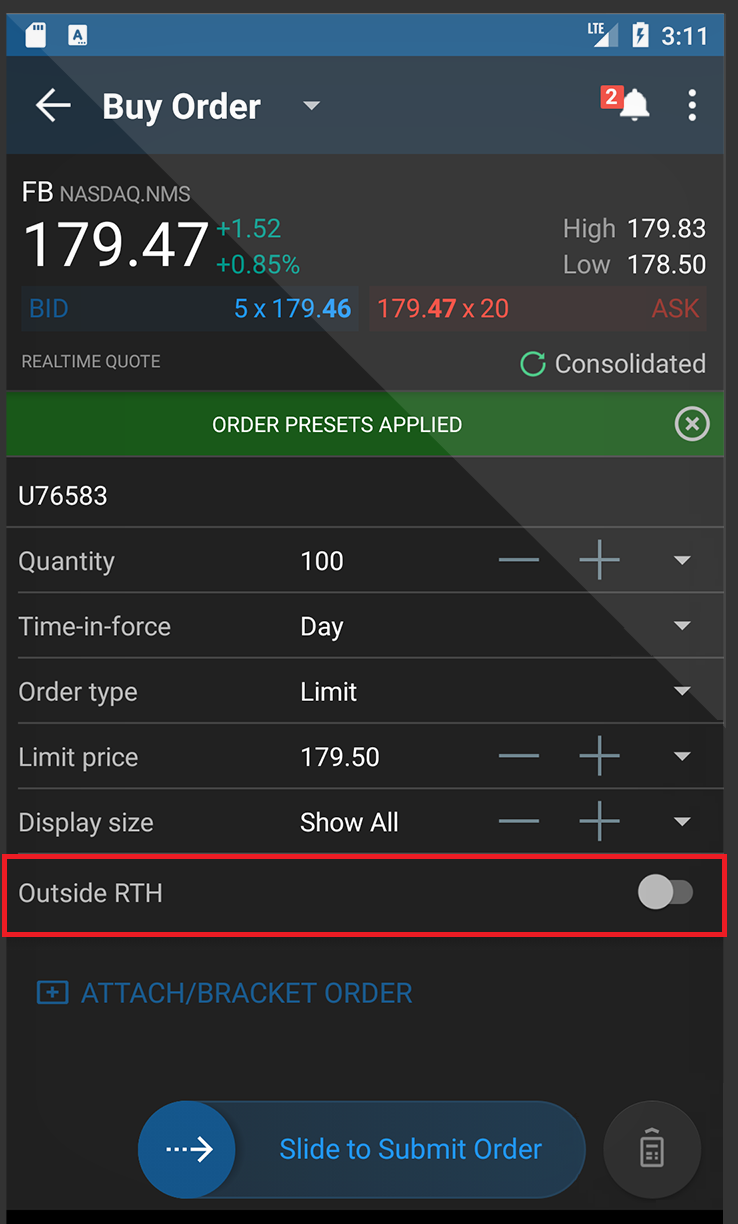
Note: The RTH restriction cannot be modified once an order has been transmitted. In order to change the RTH restriction the submitted order must be canceled and a new order entered with the appropriate RTH selection.
Changing Default Settings
Trader Workstation (TWS)
Traders can adjust the default RTH setting in the TWS as follows;
1. Select the Edit menu followed by Global Configuration at the top of the main TWS screen.
2. On the left side of the window that appears, click the "+" next to the word Presets to expand the section.
2. Next, select the product type (Stocks, Futures, etc.) by clicking on the word so that it is highlighted.
3. In the Primary Order section, be sure the Order Type is set to LMT. (if MKT or STP is set as the default the RTH setting will not be applicable).
4. In the Timing section, check the box that says "Allow order to be activated, triggered, or filled outside of regular trading hours".
5. Click Apply and then OK at the bottom of the window.
6. Orders that support modification of the RTH restriction (for the product selected in step #1) will be created with the new default applied.
IBKR Mobile
Traders can adjust the default RTH setting in IBKR Mobile (iOS or Android) as follows;
- Tap the menu (More) button and select Configuration

- Look for the Cloud section and tap Trading Settings

- Tap the Product that you wish to edit the Presets for
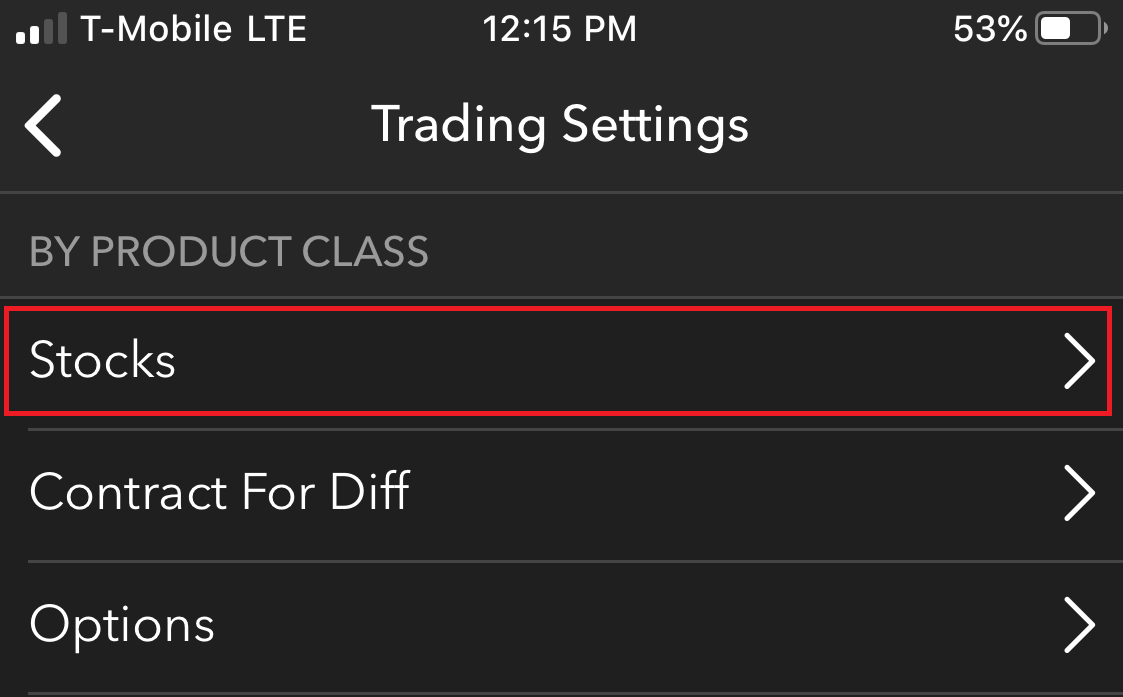
- Tap the Timing line item

- Toggle Outside RTH on or off. Once finished simply tap the back button to save your changes to the Cloud.
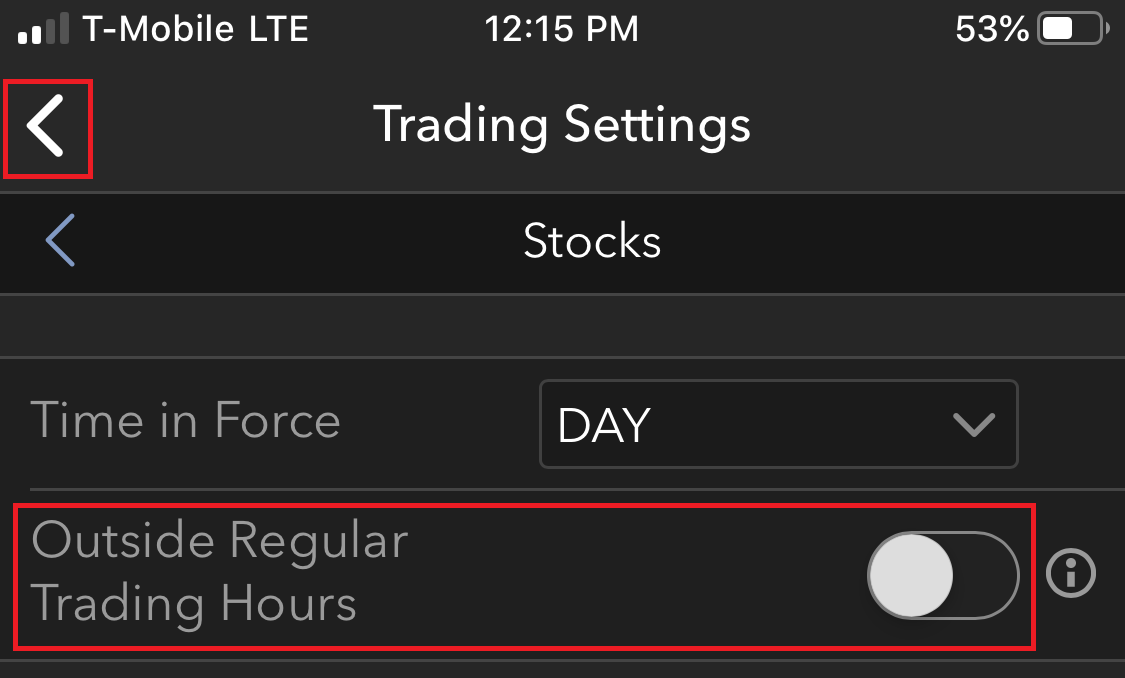
Other Important Notes:
* Traders unfamiliar with the Regular Trading Hours for a particular product may right click on the market data line and choose Contract Info followed by Description. This window will list the Regular Trading Hours for the selected product.
* Forex, OTCBB, and Pink Sheet securities do not have a Regular Trading Hours designation as there is no centralized marketplace or primary exchange. Traders should use caution when trading these products during the early and late sessions as orders will execute regardless of any default RTH restriction previously applied.
* Outside Regular Trading Hours for IBKR Pro accounts begins at 4:00 EST and lasts until market open, and restarts at market close until 20:00 EST. Outside Regular Trading Hours for IBKR Lite accounts begins at 7:00 EST and lasts until market open, and restarts at market close until 20:00 EST. Regular Trading Hours for both account types are 9:30-16:00 EST.
* For stocks, Market orders and Stop orders (which, when triggered, become Market orders) are only active from 09:30 until 16:00 EST (the Nyse's regular trading hours session). To have the order active in all sessions including the Premarket hours, Regular Trading Hours and the Aftermarket hours, you must use a Limit or Stop Limit type order and add the attribute "Allow Outside RTH". The same settings apply for CME/CBOT/NYMEX/COMEX Future contracts. The Nybot accepts Stop orders and converts them internally to "Stop with Protection" orders that are active for all available hours. A Future contract's RTH session is detailed in the contract's description window.
Is there a training manual for the Trader Workstation?
Yes, IBKR provides a Users' Guide for the Trader Workstation as well as our other trading platforms. The Users' Guides can be found on the website by clicking Support followed by For Individuals. Scroll down and click the User Guides icon.
You can access the TWS User's Guide at the following link: TWS User's Guide. Should you decide to print it out there is also a printable version available, but please be aware that it is very long. Once the online guide has loaded, you can navigate through the guide with the "Contents" or "Index" tabs. For quick access to information on a particular issue you can use the Search button found at the top of the page.
How do I enter the symbol for Berkshire Hathaway Class B shares onto TWS?
There are a variety of symbol conventions for denoting Berkshire Hathaway Class B shares (CUSIP 084670207). On the IBKR trading platforms, this security is designated by entering BRK, then a space and then B (BRK B). This compares to Bloomberg which uses the convention BRK/B and Yahoo Finance which uses BRK-B.
It should also be noted that this security has been designated as a 10-share unit issue by its primary listing exchange, NYSE Arca, due to its relatively low trading volume. A round lot in this security is therefore set at 10 shares as opposed to the standard round lot unit of 100 shares. If your opening buy or sell order is for an amount less than 10 shares, it is considered an odd-lot and subject to special handling considerations. Please review our website under the Trading and then Order Types menu options for additional details.
How do I add the field OCA Group to my Trader Workstation trading page?
Towards the top right corner of the TWS Order Management Screen, you will see a "Trader Workstation/Ticker Lookup" search field. Immediately to the left of this you will see a wrench shaped icon. Click the icon. From here, click on the Order Columns tab from the TWS Configuration window. On the right side under Available Columns, click on Order Attributes to expand that selection and see all of your choices. Click on OCA Group so that it is highlighted. Then click on the Add button. This will add OCA Group to the Shown Columns list. Now click on the Apply button at the bottom of the window, and then the OK button. The OCA Group column should now be on your TWS Order Management page.
Note: Because the OCA procedure is an automated process, there is no guarantee that requested cancellations and modifications will reach the specific exchange before an order has been executed.
The P&L in my Account Window does not match the P&L displayed on the Trader Workstation.
Please note that both Realized and Unrealized P&L on Trader Workstation are for informational purposes only. They neither add, nor subtract, anything from your account. The actual P&L credited to or debited from the account is computed from the opening trade price to the closing trade price. This information can always be found in the daily activity statement for the account. The P&L values displayed use the market price value when computing the value that is being displayed. The system gives less weight to pre and post market transactions due to the lack of liquidity and the width of the spreads. As a result of this, the previous close is used until the NYSE market opens at 09:30 EST.
The Account Window utilizes the following formulas to calculate P&L: Unrealized P&L is the difference between the current market value of your open positions and the average cost, or Value – Average Cost; Realized P&L shows your profit on closed positions, which is the difference between your entry execution cost and exit execution cost, or (execution price + commissions to open the position) – (execution price + commissions to close the position).
The Order Management page on TWS utilizes two different P&L calculation methods. It is for the account holder to decide which calculation method they wish to have displayed: Daily P&L is calculated for all positions you currently hold using the new position calculation and the formula (current price) – (prior day’s closing price) x (total number of outstanding shares); while New Position P&L is calculated for transactions executed today using the formula (current price) – (purchase price) x (number of outstanding shares purchased today).
How can I close my open positions in the event my Internet connection is disrupted?
IB maintains a trade order desk within each of its US, European and Asian Customer Service Centers, effectively providing 24 hour support for phone orders. Traders should note that the order desk facilitates closing market orders only and such orders are assessed a Telephone Order fee of USD 30, or equivalent, in addition to all regular commissions. A listing of phone numbers for each of the Service Centers which we recommend you print and maintain in the event you experience an Internet outage may be found here.
How, under the Windows operating system, do I create a screen shot to send to IBKR?
For some support related issues, obtaining a screenshot may provide valuable information that will assist us with resolving the issue being experienced. The following page describes two different methods of creating a screenshot.
Manual Screenshot
For traders not using the TWS, the following describes the process of creating a screenshot and attaching it to a web ticket to submit to Client Service.
To provide an image of your full computer screen select and hold down the ‘Ctrl’ key and then the ’Print Screen‘ key (located in the upper right corner of the keyboard).
For an image of a single window within your screen select and hold down the ‘Alt’ key and then the ‘Print Screen’ key
Next, open a text or image editing program such as Microsoft Word to ‘paste’ and save the shot you’ve just created. Once the program has opened select and hold down the 'Ctrl' key and then hit the “V” key. Verify that this is the image you wish to send and then save the document to your computer. Log in to Advisor Portal and select the Message Center from where you can create a new web ticket and attach your document.
TWS Screenshot / Log File
Traders using the TWS software can use keyboard combinations to capture snapshots of their screen and upload them to assist with support issues.
To create a snapshot of the TWS screen and upload the log file please use the keyboard combination associated with the type of machine being used;
- All PC's except HP's: Ctrl+Alt+H
- Hewlet Packards (HP): Ctrl+Alt+Q
- Mac: Ctrl+Option+H
A window will appear allowing the trader to enter text and check the screenshot box to include an image of the computer screen.
.jpg)
After pressing submit, the following window will appear to acknowledge that the files have been uploaded.
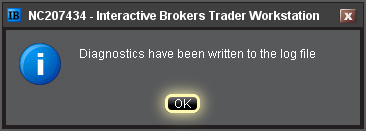
Notes:
- Client Service does not monitor these uploads during the day so be sure to communicate with the Client Service desk prior to uploading files relating to a current issue.
- Traders behind a firewall or proxy may be unable to upload log files and screenshots using the TWS method.
How can I request for a replacement secure login device or temporary security code?
IBKR is committed to protecting your account and your account assets from fraudulent practices. The Secure Login System provides an extra layer of security to your account. For security purposes, all replacement security device requests must be addressed via telephone and only after the identity of the named account holder or authorized user has been verbally verified. For assistance in accessing your account immediately and obtaining a replacement security device, please contact IBKR Client Services via telephone to restore login access.
References
- See KB69 for information about Temporary passcode validity
- See KB1131 for an overview of the Secure Login System
- See KB2636 for information and procedures related to Security Devices
- See KB2481 for instructions about sharing the Security Login Device between two or more users
- See KB2545 for instructions on how to opt back in to the Secure Login System
- See KB975 for instructions on how to return your security device to IB
- See KB2260 for instructions on activating the IB Key authentication via IBKR Mobile
- See KB2895 for information about Multiple 2Factor System (M2FS)
- See KB1861 for information about charges or expenses associated with the security devices
How long does a Temporary Security Code last?
IBKR will issue a temporary passcode to Secure Login System participants in the event their security device has been misplaced, lost or damaged. The temporary passcode is intended to provide full access to both Client Portal and trading platforms for a period of 2 days. After 2 days, the temporary passcode may no longer be used to access the trading platforms but may be used to access Client Portal for an additional period of 8 days. Client Portal access, however, is limited solely for the purpose of printing or saving the Online Security Code Card.
The Online Security Code Card, in contrast, has a lifespan of 21 days, providing the account holder with an opportunity to locate the misplaced device or have continuous access in case the device is lost or damaged, and needs replacement. Account holders who remain without their physical security device and who are unable to log in using either the temporary passcode or Online Security Code Card will need to contact Client Services (ibkr.com/support) in order access their account.
The quickest solution to restore permanent access to your account, is to install and activate the IBKR Mobile authentication with IB Key. Details about the instant activation of the smartphone app can be found here.
IMPORTANT NOTICE
As a matter of policy, IBKR will not issue consecutive temporary passcodes to a given account, but rather will act to restore the account protection to the most secure level, which is provided by a physical security device.
References
- See KB70 for instruction for requesting a Temporary Passcode
- See KB1131 for an overview of the Secure Login System
- See KB2636 for information and procedures related to Security Devices
- See KB2481 for instructions about sharing the Security Login Device between two or more users
- See KB2545 for instructions on how to opt back in to the Secure Login System
- See KB975 for instructions on how to return your security device to IBKR
- See KB2260 for instructions on activating the IB Key authentication via IBKR Mobile
- See KB2895 for information about Multiple 2Factor System (M2FS)
- See KB1861 for information about charges or expenses associated with the security devices



